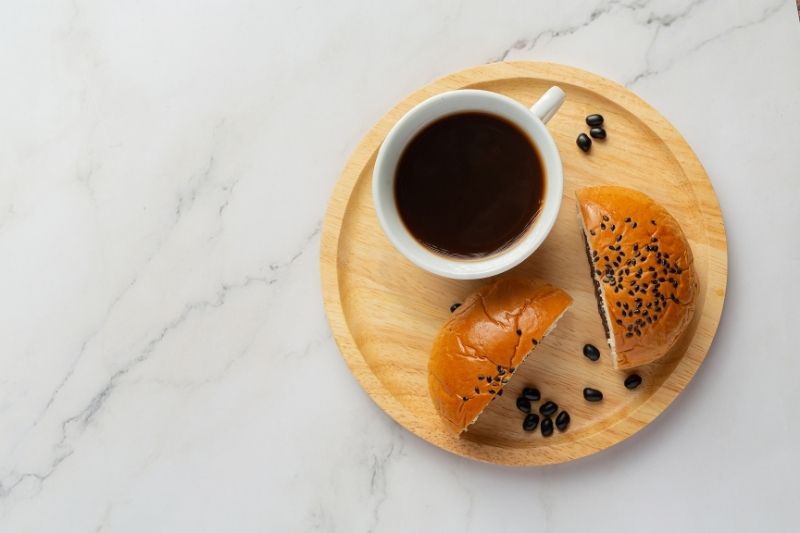Anko Coffee, have you heard of it? The name of this drink is as interesting as the combination of ingredients it is made of. It is made by mixing ‘Anko' (Japanese sweet red bean paste) with freshly brewed black coffee. Who would have thought of adding red beans to coffee?! You might be second-guessing it, but give it a try, and you will be pleasantly surprised.

Your mind might be buzzing with questions like ‘what exactly is Anko?' 'Can I make it at home?' 'How did this trend start?' and so on; today, in this article, we will answer all the questions you might have about Anko Coffee, so let’s get started!
What exactly is Anko?
‘Anko’ is a sweet paste or jam made from boiled Japanese red beans called ‘Azuki beans,' water, and sugar. It is a common ingredient used in Japanese cuisine, especially for making traditional Japanese sweets. Sweet, hearty, and filling, ‘Anko’ paste is a great condiment to use for making desserts; no wonder that it pairs so well with coffee. The sugar in the Anko paste acts as a natural preservative, and if it is kept in an airtight container inside a fridge, it can last for weeks.
What does Anko Coffee taste like?
If you think straight black coffee is a bit too strong for your taste, you will love Anko Coffee! The sweetness of the Anko balances the bitterness of coffee perfectly. Not only that, the Anko paste adds richness, depth of flavors, and volume to your cup of coffee. As a result, Anko coffee is sweeter, creamier, and more filling and dessert-like than a plain cup of coffee.
Nagoya – The origin of Anko Coffee
The unique trend of mixing red bean paste with coffee started in Nagoya – the fourth largest city in central Japan. Nagoya is known to have the highest Anko consumption in Japan, and the numerous cafes and kissaten in Nagoya are popular for serving Anko-themed desserts and drinks. The most famous of these beloved Nagoya cafes is Komeda Coffee, a longstanding café established in 1968, with more than 800 branches across Japan today. This very café popularized the Anko coffee, with the special item on their menu called ‘Azuki Komachi,' which has Azuki red beans inside a cup of black coffee, with the option to have whipped cream on top.
You can visit Komeda Coffee on your next trip to Japan and enjoy the iconic Coffee Azuki Coffee, but until then, let’s read on to find out how you can make Anko-coffee just as good as Komeda’s at the comfort of your home! (Komeda Coffee is one of the top 10 Japanese Coffee Shops I mentioned in)
How to make Anko Coffee at home
First of all, let’s address some questions you might have about making Anko Coffee at home so that any confusion regarding the ingredients is cleared out.
Tsubuan or Koshian - which type of Anko to use for Anko Coffee?
There are two main types of Anko depending on the texture of the paste – Tsubuan and Koshian. In the Tsubuan type, you can enjoy the chunky texture of the skin and flesh of the boiled beans, as the beans are roughly crushed but not completely mashed. On the other hand, the Koshian type has a fine texture with a smooth mouthfeel as the beans are thoroughly mashed and the skins are removed.
You can use both types to make Anko Coffee depending on your preference. However, if it is your first time trying this coffee, it might be better to go with Koshian (the smoother type), as it will mix better with coffee.
Where can you find Anko paste for making Anko Coffee?
In Japan, pre-made Anko is readily available at the stores. Outside Japan, you can find it in Asian grocery stores, but if you don’t, you can follow the easy guide included in this article where we tell you how to make it at home!
What type of coffee is best for Anko Coffee?
Brew
Anko Coffee is usually made with medium to strongly brewed pour-over or espresso-based coffee at cafes. However, you can even use instant coffee at home to make it as long as you are using good quality Coffee. It might be best not to use French press or Turkish coffee brewing methods, which has the chance of having sediments at the bottom as they will mix with the Anko bean paste. (I explain different brewing type in this article, please refer.)

Bean and roast type
It is best to use a medium to dark roasted coffee with a smooth buttery mouthfeel to balance out the roughness that might come from mixing the Anko. Blend or single-origin coffee with sweet, nutty, and chocolaty notes with a well-rounded taste and flavor will allow the flavor and taste of the Anko to be highlighted to its full potential. It is best to avoid coffee with high acidity and bold fruity or floral flavors.
My personal favorite is using Quattro Mountain Espresso Grind for this since this coffee has very bold taste that goes very well with Anko.
Ingredients
-
Freshly brewed hot coffee
-
Azuki red beans 200g (Either pre-made Anko like this, or create fresh from Azuki bean– see below)
-
Water (as needed)
-
Sugar 200g
Preparation
First of all, let’s make the Anko paste. Using pre-made, store-bought Anko paste works fine as well. But it is better to make it at home as you can control the texture of the Anko as well as how much sugar you want to put into the paste.
The standard ratio of red beans to sugar for the perfect Anko paste is 1:1.
-
Boil the Azuki red beans with 4-5 cups of water for 5 minutes and throw away the water. (There is no need to soak the beans beforehand)
-
Next, take a new pot with 4-5 cups of clean water and simmer the beans in it for 1.5 to 2 hours until the beans are soft and can be easily crushed by your fingers. Throw away the water when the beans are ready. (Throwing away the water removes astringency from the beans and is very important to have an Anko paste without any unpleasant tastes)
-
Place the soft beans in a clean pot with the sugar on medium-low heat for about 10 minutes until a shiny paste is formed. You will have to keep on stirring the paste constantly during these 10 minutes.
-
If you are making Tsubuan, the paste is ready. If you want Koshian (finer texture) instead, then strain the beans through a fine-mesh sieve as many times as needed after step 2 until the skins are removed and the paste looks smooth without the chunkiness.

Now let’s mix the Anko paste with coffee!
-
Add a tablespoon of the Anko paste into your favorite cup or mug. (If the paste is too dry and hard, you can add a few drops of hot water or coffee in the beginning and stir until the paste is soft)
-
Pour freshly brewed hot coffee to fill the cup.
-
Stir well until the Anko paste is mixed well with the coffee.
-
Anko Coffee is now ready to be enjoyed, but if you wish, you can also tweak it by adding condiments such as milk, cream, whipped cream topping, etc.
Bonus Tip: Remember to keep a spoon handy as you would love to scoop up the delicious remnants of the red beans at the bottom of the cup.
Health Benefits of Azuki red beans
Anko Coffee is a delicious way to intake nutritional elements that are highly beneficial for your health. Azuki beans are rich in dietary fiber, which promotes healthy digestion, proteins that help you build muscles, and minerals such as Manganese that are important for maintaining healthy bones and tissues.
Azuki beans are also naturally gluten-free. On top of that, it contains more than 29 types of anti-oxidants, chemicals that prevent cell damage and lower the risk of different kinds of diseases such as heart diseases and cancer.
Final Words
Azuki beans used to make the Anko for Anko Coffee are yummy and full of nutritional components; they also symbolize good luck and fortune. They are an essential part of the Japanese culture and are often used as a part of celebratory occasions and festivals. So maybe having a cup of Anko Coffee in the morning will not only keep you energized but also bring some surprise good luck for the day!
• Disclosure: I only recommend products I would use myself, and all opinions expressed here are my
own. This post may contain affiliate links that I may earn a small commission at no additional cost to you.
The commission also supports us in producing better content when you buy through our site links.
Thanks for your support.
- Kei and Team at Dream of Japan
Get Free Bonus Books

Sign up for free to the Japanese Coffee Club to get advice and exclusive articles about how to choose Japanese Coffee, and tips, tricks, and recipes for enjoying Japanese coffee.



























